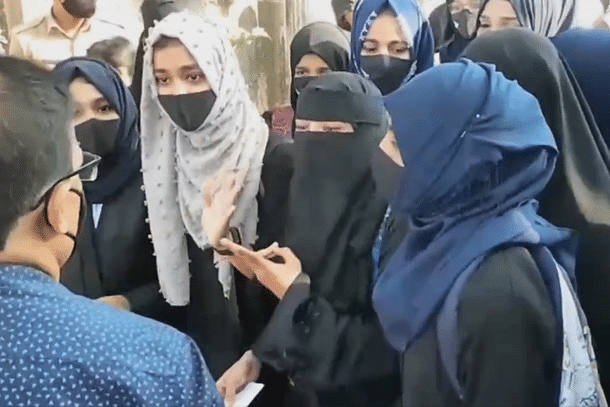
Hijab row: Protests & chaos still order of the day in colleges

Protests and confusion marked the second day of the reopening of colleges in Karnataka on Thursday (February 17), after they had been shut down for a week over disputes concerning the wearing of hijab in educational institutions.
There was confusion and chaos in a few degree colleges which have uniforms for students whether the hijab is allowed or not, though Karnataka Chief Minister Basavaraj Bommai had clarified that the high court interim order only applied to junior colleges.
In its interim order last week, the high court had restrained students from wearing saffron shawls, scarves or hijab within the classroom in institutions where college development committees had prescribed a student dress code or uniform.
On Wednesday, CM Bommai told the state legislative assembly that the court order did not apply to degree colleges but only to pre-university institutions. But a few degree colleges still did not allow their female students to wear the hijab or burqa in the classroom.
About 20 Muslim students at Ballari’s Saraladevi Satheshchandra Agarwal (SSA) Government First Grade College insisted on entering the classrooms with their hijab but the college authorities refused to let them do so. Subsequently, the students and parents gathered outside the college to protest.
Also read: What about turban, cross? Lawyer for Muslim girls asks Karnataka HC
The SSA college authorities, which has had uniforms for students for the past 20 years, however, said that they were just following the high court order. Moreover, there has been no specific instructions from the education department on this matter at all.
“There is confusion. We are just following the high court directions, that is all,” said Prof A Hemanna, the college principal. Since internal tests are going on, the students will be given alternative dates, he said.
Meanwhile, at the Dr G Shankar Government Women’s First Grade College in Udupi, some Muslim students had to return home as they were barred from entering the classrooms with the hijab. According to college principal Bhaskar Shetty, the institution’s college development committee had introduced uniforms in 2010. But the college had allowed girls to wear the hijab in classrooms.
“Until the high court interim order, we had allowed our students to wear the hijab,” he said. “As per the order, it is strictly mentioned that colleges with uniforms are not supposed to allow their students use hijab or kesari shawl in the classroom. That’s the reason we are not permitting our students to come with hijab inside the classroom,” he said.
The parents are upset, meanwhile. “What is the reason for stopping our children? I can understand that the court order pertains to PU colleges but this is a degree college. The CM has said that the order does not pertain to degree colleges,” said Hanif Doddanagudde, a parent whose daughter studies in the same college.
He had dropped his daughter at the college this morning but she was not allowed inside the classroom with the hijab. “What wrong have we done? We do not want to violate any court orders or government orders. But our children are being deprived of their education,” he said.
Many degree colleges did not allow students to enter their premises with the hijab despite the CM’s clarification, said T M Jafrulla, a social activist from Udupi. In a memorandum to the Udupi deputy commissioner, Jaffrulla said that many institutions were misusing the court’s interim orders. “It is exam time and two years have already been impacted by COVID. This is about the students’ future,” he told The Federal.
Meanwhile, Dr B G Bhaskara, president of Federation of University and College Teachers Associations in Karnataka felt that largely academic activities in colleges across the state went off smoothly barring a few incidents.
“Ninety per cent of the degree colleges do not have uniforms. Since we do not have uniforms, the students are free to wear what they want,” said Bhaskara, who is also principal of Vivekananda Degree College in Bengaluru. In his institution, he pointed out that more Muslim students were opting to wear the hijab, when they were not doing so earlier.
“The number has slightly increased. Few girls who were not wearing hijab earlier have started wearing it now,” he said.

